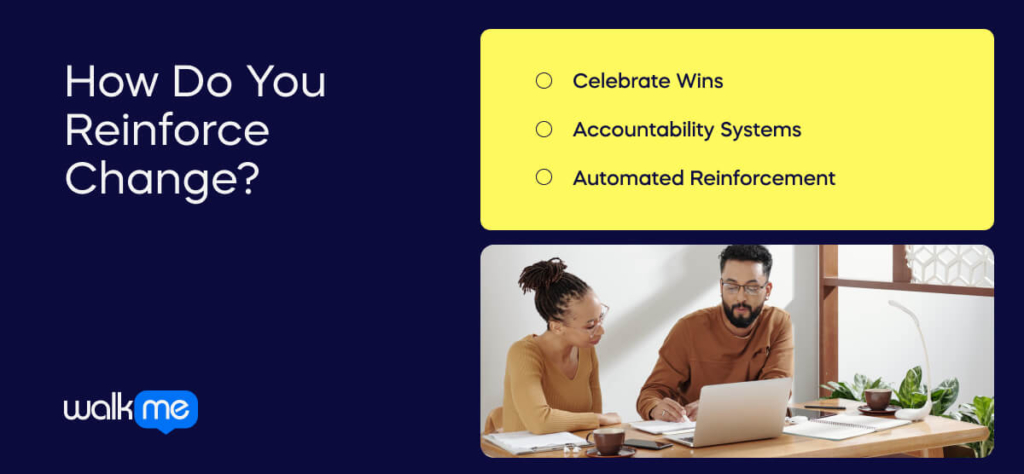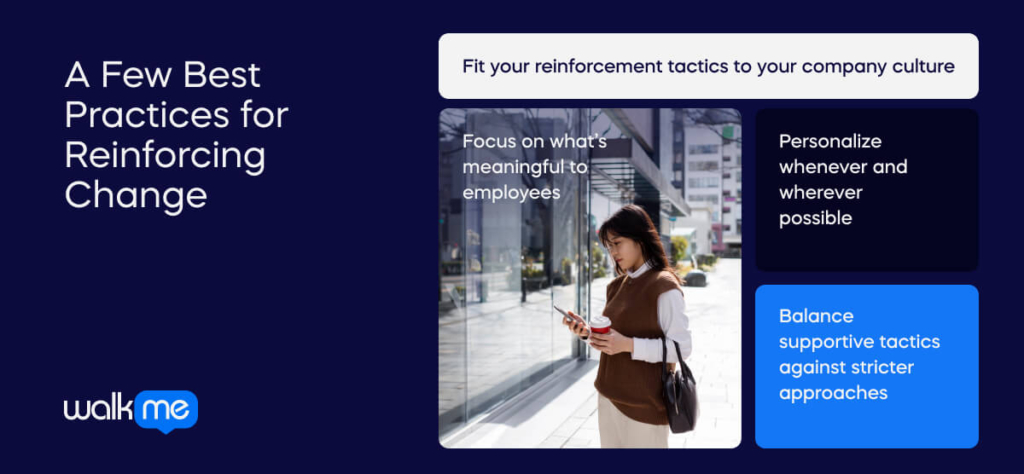Reinforcing change is an essential stage in change management models.
It may seem like a small thing, but reinforcement can make or break your program.
Below, we’ll answer many top questions about change management, including:
- What “reinforcing change” means
- Why reinforcement matters
- How and when to reinforce change
And so on.
Let’s start with the most basic question…
What Does “Reinforcing Change” Mean?
Reinforcing change is a process in change management.
Its purpose is to sustain change – to maintain it even after the change program is complete.
Many leaders in the field recognize reinforcement as an essential part of every change process.
It is included, for instance, in popular change models such as the ADKAR framework and John Kotter’s 8-Step change model.
Why Reinforce Change?
Reinforcing change is necessary to make sure a change actually sticks.
Without reinforcement, your target audience – such as employees or managers – may revert to the old ways of doing things.
Reverting old habits is common because:
- People prefer what is familiar, comfortable, and easy
- Those who resisted change may continue to resist change, even after the project is complete
- If the project requires extensive employee training – or if people are less involved – then people may actually forget what needs to be done
In short, if you don’t reinforce change, all your hard work may vanish.
To counteract these problems, it’s necessary to create mechanisms and systems that help your change become the new status quo.
Below, we will discuss such systems in more detail.
Who Reinforces Change?
Developing a strong system for reinforcement is crucial.
In that mechanism, you can assign reinforcement tasks to different parties, including:
- The core change team
- Change champions or change advocates
- Employees themselves
- Business leaders and executives
- Or even automated systems and software
The key in developing successful change programs is less about who reinforces change, but more about how you do it. And whether it is effective.
When Is the Best Time to Reinforce Change?
Typically, change models reinforce change at the end of a change project.
During a change project, employees, managers, and change practitioners are still involved in the change.
They are constantly reminded of the change, so reinforcement is often unnecessary.
However, after project completion, many business leaders may falsely feel that the project is complete.
For this reason, established change frameworks make reinforcement the final step in their project.
However, Prosci advises using reinforcement techniques throughout your change project … right from the start.
Celebrating small successes early on can build momentum and maximize your chances of success.
How Do You Reinforce Change?

Reinforcing change can take different forms, depending on your circumstances.
Here are some methods for creating systematic reinforcement:
- Celebrate Wins – Recognition, awards, contests, and gamification are good ways to reward people for making progress.
- Accountability Systems – Regular, open audits of progress can serve as constant reminders of change, responsibility, and accountability.
- Automated Reinforcement – Smart use of digital technology can help you automate many reinforcement mechanisms, through digital training platforms, employee onboarding systems, and so on.
The key to success is to test a few different methods, then find ones that work best in your situation.
How Do You Know It’s Working?
Every change initiative should be closely monitored.
Chances are, you are already tracking metrics across a variety of areas. These metrics can tell you what is working … and what areas are slowing.
Measure your change initiative with:
- Feedback – Regularly collect feedback from your employees to understand their perspective. This can offer insight into what needs fixing.
- Data and Analytics – Data and analytics, in the case of software adoption, for example, can tell you what functions are slowing or reverting. This information can help you create appropriate reinforcement mechanisms.
- Metrics – Key performance indicators (KPIs) are targets that must be met during your change program. Lagging KPIs can help you reinforce when and where it’s needed.
However, don’t wait on data to start celebrating wins and reinforcing change.
Use data to analyze the health of your program, and follow where it leads.
But start reinforcing as soon as possible in order to build and maintain momentum.
What Are a Few Best Practices for Reinforcing Change?

Here are a few final tips:
- Fit your reinforcement tactics to your company culture. Every company has a different work culture, so your reinforcement techniques should fit your culture. Amazon, for instance, is known as a competitive, fast-paced work environment. What works there wouldn’t suit a more relaxed workplace.
- Focus on what’s meaningful to employees. Rewards should add meaning and value to an employee, otherwise it won’t carry much weight. If you use games or other change management exercises, for instance, find out what types of rewards or recognition would be most meaningful, then implement those.
- Personalize whenever and wherever possible. Ultimately, change management is about the individual. The more you can personalize your reinforcement – even with one-on-one recognition – the more successful your reinforcement efforts. Consider, for example, ways to personalize rewards for individuals, and monitor results.
- Balance supportive tactics against stricter approaches. A reward is positive reinforcement, while penalties are negative. Accountability systems and audits are effective, but they should be balanced with positive reinforcement, such as rewards, recognition, and praise.
These are a few ways that you get better results when reinforcing change.

